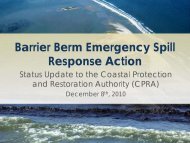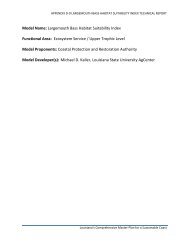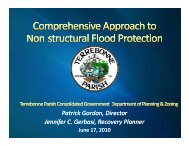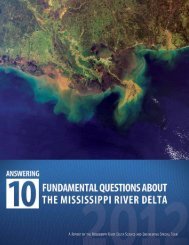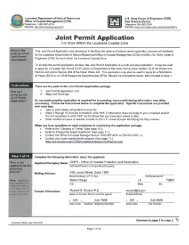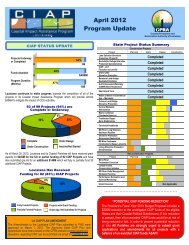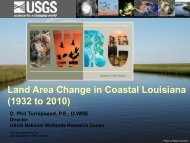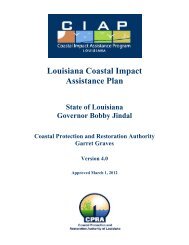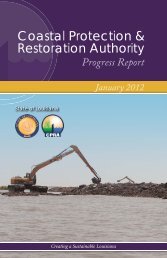barrier island status report - Coastal Protection and Restoration ...
barrier island status report - Coastal Protection and Restoration ...
barrier island status report - Coastal Protection and Restoration ...
You also want an ePaper? Increase the reach of your titles
YUMPU automatically turns print PDFs into web optimized ePapers that Google loves.
ft/yr. Pelican Isl<strong>and</strong> first breached between 1998 <strong>and</strong> 2004, which occurred during the shortterm<br />
interval. This breaching correlates to the amplified shoreline erosion rate. The <strong>isl<strong>and</strong></strong><br />
experienced net shoreline progradation in the near-term interval (+12.7 ft/yr on average) noting<br />
this period included the s<strong>and</strong> berm construction. The new historical average equaled -3.8 ft/yr,<br />
which was on the same order of magnitude as the BICM historical average. Thus placement of<br />
the s<strong>and</strong> berm restored some of the <strong>isl<strong>and</strong></strong>‟s geomorphic form <strong>and</strong> function, returning the<br />
historical erosion rate to pre-breach rates.<br />
Construction of Barrier Berm reach W9<br />
along Pelican Isl<strong>and</strong> started on July 18,<br />
2010 <strong>and</strong> was completed by October 2,<br />
2010. S<strong>and</strong> was transported from reh<strong>and</strong>ling<br />
area 35-E <strong>and</strong> emplaced within<br />
the construction template, which was<br />
identical to the template used for the other<br />
berm reaches. The template was<br />
superimposed on the existing <strong>isl<strong>and</strong></strong> <strong>and</strong><br />
within the footprint of the CWPPRA<br />
Pelican Isl<strong>and</strong> <strong>Restoration</strong> Project (BA-38-<br />
2). A total length of 12,700 feet of berm<br />
was constructed <strong>and</strong> approximately<br />
1,294,000 cubic yards of s<strong>and</strong> was<br />
emplaced within the berm along Pelican<br />
Isl<strong>and</strong>. Monitoring of emergency s<strong>and</strong> berm<br />
reach W9 indicates that 79% of the material<br />
had been retained after the first 360-day<br />
monitoring event.<br />
Figure 37. Pelican Isl<strong>and</strong> Average Shoreline<br />
Change Rates (CEC, 2012).<br />
4.4.6 Scofield Isl<strong>and</strong><br />
Presented in Figure 38 are the average<br />
shoreline change rates for Scofield Isl<strong>and</strong>.<br />
Similar to Pelican Isl<strong>and</strong>, it is noted this<br />
<strong>isl<strong>and</strong></strong> was the site of emergency berm<br />
W10 as part of the Barrier Berm Project<br />
(Thompson, 2012). The pre-berm erosion<br />
rates ranged from -11.7 ft/yr (BICM longterm)<br />
to -30.2 ft/yr (BICM short-term)<br />
noting the short-term average was over 2.5<br />
times the long-term average <strong>and</strong> over 1.5<br />
times the BICM historical average equal to<br />
-18.5 ft/yr. Scofield Isl<strong>and</strong> first breached<br />
between 1998 <strong>and</strong> 2004, which occurred<br />
during the short-term interval.<br />
Figure 38. Scofield Isl<strong>and</strong> Average Shoreline<br />
Change Rates (CEC, 2012).<br />
44 | P a g e



